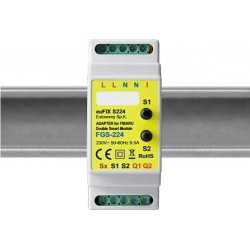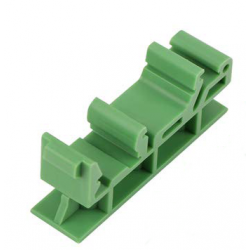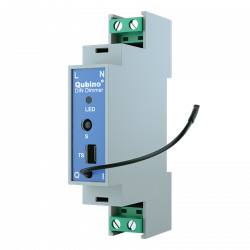Sem produtos
Preços com IVA
Produto adicionado com sucesso ao seu carrinho de compras
Existem 0 produtos no seu carrinho de compras. Existe um produto no seu carrinho de compras.
Produtos visualizados
-

Shelly Qubino Wave Pro...
Switch inteligente profissional de...
-

ZIPATO - Z-WAVE+...
O sensor de monóxido de carbono...


Shelly Qubino Wave Pro 2PM - Módulo em trilho DIN de 2 canais Z-Wave 800 com medidor de consumo
QPSW-0A2P16EU
Novo
Switch inteligente profissional de trilho DIN Z-Wave de 2 canais com medição de potência, adequado para instalações de automação residencial e controle remoto. Montagem em trilho DIN dentro de uma caixa de disjuntor. Recursos de segurança aprimorados.
Em estoque
- Retirar este produto da minha lista de favoritos.
- Adicionar este produto à minha lista de favoritos.
Características tecnicas
| Tecnologia Domótica | Z-Wave Serie 800 |
Mais Informação
Wave Pro 2PM é um relé monofásico de 2 canais que suporta até 16 A por canal, com capacidade total do dispositivo de 25 A. Possui dois medidores de energia integrados que permitem ao cliente controlar e monitorar o consumo de cada canal separadamente. e/ou conjuntamente. Diferentes tipos de ações, cenários e horários podem ser programados para sincronizar seu ambiente com suas atividades diárias ou profissionais.
Shelly Qubino é alimentado por Z-Wave
Graças ao Z-Wave, os produtos de automação residencial podem se comunicar perfeitamente entre si, independentemente da marca ou plataforma, graças a um hub inteligente centralizado! Os dispositivos Shelly Qubino são alimentados pelo chip Z-Wave de próxima geração (S800), uma das tecnologias padronizadas mais populares do mundo para casas inteligentes.
Funciona com qualquer gateway Z-Wave
O Wave Pro 2PM foi adaptado e projetado para caber atrás de interruptores/botões. Depois de instalado, inclua o dispositivo em sua rede Z-Wave (é necessário gateway Z-Wave) e controle-o usando seu smartphone ou tablet. Os dispositivos Shelly Qubino funcionam com mais de 4.000 dispositivos e gateways certificados Z-Wave.
2 saídas, 16 A cada
Wave Pro 2PM tem uma saída total de 25A.
Medição do consumo de energia
O Wave Pro 2PM oferece monitoramento preciso do consumo de energia canal por canal (W) ou global (W, kWh).
Ampla gama de tensões suportadas
Use-o para controlar uma ampla variedade de dispositivos e aparelhos AC.
Associações
Estabeleça comunicação direta entre dispositivos em sua rede Z-Wave local e configure ações sem a necessidade de um hub.
O mais alto nível de segurança
Inclui o dispositivo como Security 2 Authenticated para comunicação criptografada e segurança máxima da sua rede Z-Wave.
FUNÇÕES do Shelly Wave Pro 2PM
- 2 saídas de 16 A cada. Saída total máxima de 25A.
- Medição do consumo de energia em cada canal separadamente e em conjunto.
- Montagem em trilho DIN
- Controle monofásico
- Consumo de energia extremamente baixo: <0,3W
- Banda de frequência Z-Wave: 868,4 MHz (países CEPT)
- Tecnologia mais recente: série Z-Wave 800
- Configuração automática com SmartStart
- Segurança 2 Autenticado para o mais alto nível de segurança
- Atualizações de firmware sem fio
- Funciona com gateways Z-Wave certificados e mais de 4.000 dispositivos Z-Wave
Informação alargada da Z-Wave (Inglês)
Note! All Device outputs (O, O1, O2, etc. - depending on the Device type) will turn the load 1s on/1s off /1s on/1s off if the Device is successfully added to/removed from a Z-Wave® network.
Note! In case of Security 2 (S2) adding (inclusion), a dialog will appear asking you to enter the corresponding PIN Code (5 underlined digits) that are written on the Z-Wave® DSK label on the side of the Device and on the Z-Wave® DSK label inserted in the packaging.
IMPORTANT: The PIN Code must not be lost.
SmartStart adding (inclusion)
SmartStart enabled products can be added into a Z-Wave® network by scanning the Z-Wave® QR Code present on the Device with a gateway providing SmartStart inclusion. No further action is required, and the SmartStart device will be added automatically within 10 minutes of being switched on in the network vicinity.
1. With the gateway application scan the QR code on the Device label and add the Security 2 (S2) Device Specific Key (DSK) to the provisioning list in the gateway.
2. Connect the Device to a power supply.
3. Check if the blue LED is blinking in Mode 1. If so, the Device is not added to a Z-Wave® network.
4. Adding will be initiated automatically within a few seconds after connecting the Device to a power supply, and the Device will be added to a Z-Wave® network automatically.
5. The blue LED will be blinking in Mode 2 during the adding process.
6. The green LED will be blinking in Mode 1 if the Device is successfully added to a Z-Wave® network.
Adding (inclusion) with the S button
1. Connect the Device to a power supply.
2. Check if the blue LED is blinking in Mode 1. If so, the Device is not added to a Z-Wave® network.
3. Enable add/remove mode on the gateway.
4. To enter the Setting mode, quickly press and hold the S button on the Device until the LED turns solid blue.
5. Quickly release and then press and hold (> 2s) the S button on the Device until the blue LED starts blinking in Mode 3. Releasing the S button will start the Learn mode.
6. The blue LED will be blinking in Mode 2 during the adding process.
7. The green LED will be blinking in Mode 1 if the Device is successfully added to a Z-Wave® network.
Note! In Setting mode, the Device has a timeout of 10s before entering again into Normal mode.
Adding (inclusion) with a switch/push-button
1. Connect the Device to a power supply.
2. Check if the blue LED is blinking in Mode 1. If so, the Device is not added to a Z-Wave® network.
3. Enable add/remove mode on the gateway.
4. Toggle the switch/push-button connected to any of the SW terminals (SW, SW1, SW2, etc.) 3 times within 3 seconds (this procedure puts the Device in Learn mode*). The Device must receive on/off signal 3 times, which means pressing the momentary switch 3 times, or toggling the switch on and off 3 times.
5. The blue LED will be blinking in Mode 2 during the adding process.
6. The green LED will be blinking in Mode 1 if the Device is successfully added to a Z-Wave® network.
*Learn mode - a state that allows the Device to receive network information from the gateway.
Note! The Device will be removed from your Z-Wave® network, but any custom configuration parameters will not be erased.
Note! All Device outputs (O, O1, O2, etc. - depending on the Device type) will turn the load 1s on/1s off /1s on/1s off if the Device is successfully added to/removed from a Z-Wave® network.
Removing (exclusion) with the S button
1. Connect the Device to a power supply.
2. Check if the green LED is blinking in Mode 1. If so, the Device is added to a Z-Wave® network.
3. Enable add/remove mode on the gateway.
4. To enter the Setting mode, quickly press and hold the S button on the Device until the LED turns solid blue.
5. Quickly release and then press and hold (> 2s) the S button on the Device until the blue LED starts blinking in Mode 3. Releasing the S button will start the Learn mode.
6. The blue LED will be blinking in Mode 2 during the removing process.
7. The blue LED will be blinking in Mode 1 if the Device is successfully removed from a Z-Wave® network.
Note! In Setting mode, the Device has a timeout of 10s before entering again into Normal mode.
Removing (exclusion) with a switch/push-button
1. Connect the Device to a power supply.
2. Check if the green LED is blinking in Mode 1. If so, the Device is added to a Z-Wave® network.
3. Enable add/remove mode on the gateway.
4. Toggle the switch/push-button connected to any of the SW terminals (SW, SW1, SW2,…) 3 times within 3 seconds (this procedure puts the Device in Learn mode). The Device must receive on/off signal 3 times, which means pressing the momentary switch 3 times, or toggling the switch on and off 3 times.
5. The blue LED will be blinking in Mode 2 during the removing process.
6. The blue LED will be blinking in Mode 1 if the Device is successfully removed from a Z-Wave® network.
Factory reset general
After Factory reset, all custom parameters and stored values (kWh, associations, routings, etc.) will return to their default state. HOME ID and NODE ID assigned to the Device will be deleted. Use this reset procedure only when the gateway is missing or otherwise inoperable.
Factory reset with the S button
Note! Factory reset with the S button is possible anytime.
1. To enter the Setting mode, quickly press and hold the S button on the Device until the LED turns solid blue.
2. Press the S button multiple times until the LED turns solid red.
3. Press and hold (> 2s) S button on the Device until the red LED starts blinking in Mode 3. Releasing the S button will start the factory reset.
4. During factory reset, the LED will turn solid green for about 1s, then the blue and red LED will start blinking in Mode 3 for approx. 2s.
5. The blue LED will be blinking in Mode 1 if the Factory reset is successful.
Factory reset with a switch/push-button
Note! Factory reset with a switch/push-button is only possible within the first minute after the Device is connected to a power supply.
1. Connect the Device to a power supply.
2. Toggle the switch/push-button connected to any of the SW terminals (SW, SW1, SW2,…) 5 times within 3 seconds. The Device must receive on/off signal 5 times, which means pressing the push-button 5 times, or toggling the switch on and off 5 times.
3. During factory reset, the LED will turn solid green for about 1s, then the blue and red LED will start blinking in Mode 3 for approx. 2s.
4. The blue LED will be blinking in Mode 1 if the Factory reset is successful.
Avaliações
Perfecto para carril DIN
Modulo perfecto para poner en carril DIN en cuadro electrico secundario. En mi caso lo puse en cuadro de piscina. Mide lo mismo que un DPN.





























